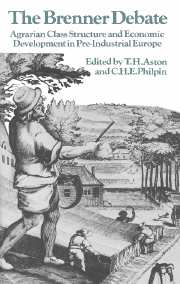Book contents
- Frontmatter
- Contents
- Preface
- Introduction
- 1 Agrarian Class Structure and Economic Development in Pre-Industrial Europe
- 2 Population and Class Relations in Feudal Society
- 3 Agrarian Class Structure and the Development of Capitalism: France and England Compared
- 4 Peasant Organization and Class Conflict in Eastern and Western Germany
- 5 A Reply to Robert Brenner
- 6 Against the Neo-Malthusian Orthodoxy
- 7 A Crisis of Feudalism
- 8 In Search of Agrarian Capitalism
- 9 Agrarian Class Structure and Economic Development in Pre-Industrial Bohemia
- 10 The Agrarian Roots of European Capitalism
- Index
- Past and Present Publications
10 - The Agrarian Roots of European Capitalism
Published online by Cambridge University Press: 27 October 2009
- Frontmatter
- Contents
- Preface
- Introduction
- 1 Agrarian Class Structure and Economic Development in Pre-Industrial Europe
- 2 Population and Class Relations in Feudal Society
- 3 Agrarian Class Structure and the Development of Capitalism: France and England Compared
- 4 Peasant Organization and Class Conflict in Eastern and Western Germany
- 5 A Reply to Robert Brenner
- 6 Against the Neo-Malthusian Orthodoxy
- 7 A Crisis of Feudalism
- 8 In Search of Agrarian Capitalism
- 9 Agrarian Class Structure and Economic Development in Pre-Industrial Bohemia
- 10 The Agrarian Roots of European Capitalism
- Index
- Past and Present Publications
Summary
INTRODUCTION
In my original article I began from the idea that social-property systems, once established, tend to set strict limits and impose certain overall patterns upon the course of economic evolution. They do so because they tend to restrict the economic actors to certain limited options, indeed quite specific strategies, in order best to reproduce themselves – that is, to maintain themselves in their established socio-economic positions. On this basis I argued that those long-term demographic and commercial trends, which hitherto have formed the foci of the standard interpretations of long-term economic development in pre-industrial Europe, acquired their economic significance for the distribution of income and the development of the productive forces only in connection with specific, historically developed systems of social-property relations and given balances of class forces. Under different property structures and different balances of power, similar demographic or commercial trends, with their associated patterns of factor prices, presented very different opportunities and dangers and thus evoked disparate responses, with diverse consequences for the economy as a whole. Indeed, as I tried to show, under different property structures and balances of class forces in various European regions, precisely the same demographic and commercial trends yielded widely divergent economic results, not only with respect to long-term trends in the distribution of income, but to overall patterns of the development or non-development of the productive forces. For this reason the relatively autonomous processes by which class structures were established, developed and transformed have to be placed at the centre of any interpretation of the long-term evolution of the pre-industrial European economy.
- Type
- Chapter
- Information
- The Brenner DebateAgrarian Class Structure and Economic Development in Pre-industrial Europe, pp. 213 - 328Publisher: Cambridge University PressPrint publication year: 1985
- 110
- Cited by

